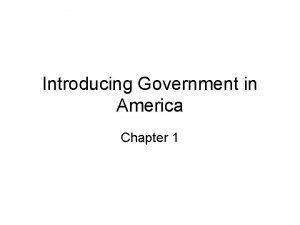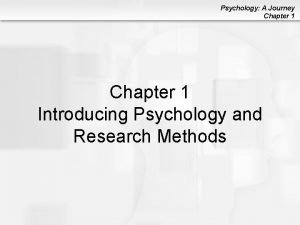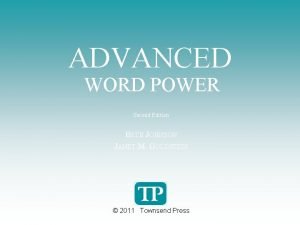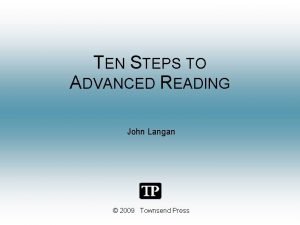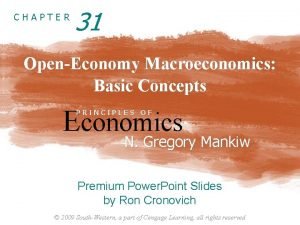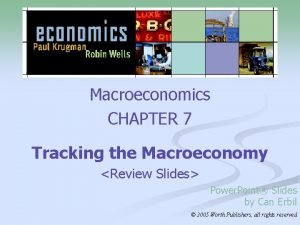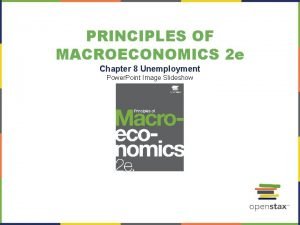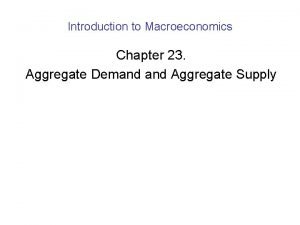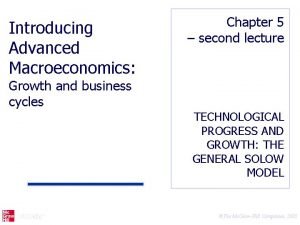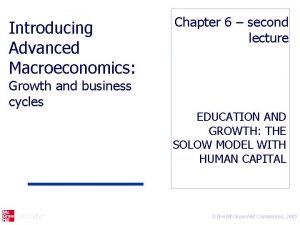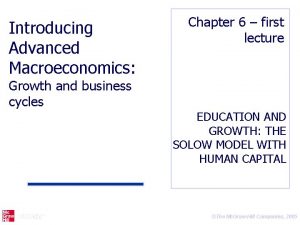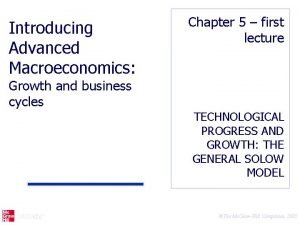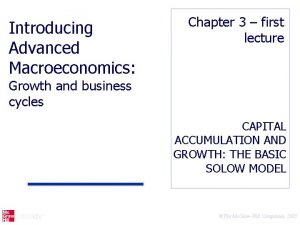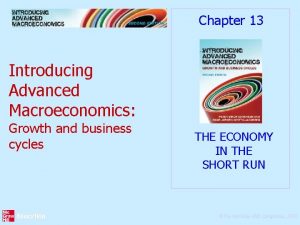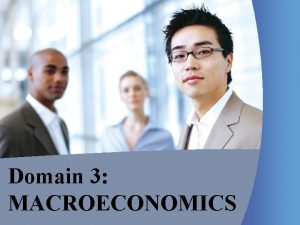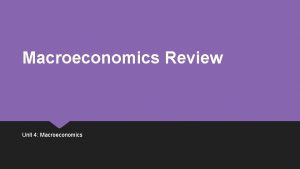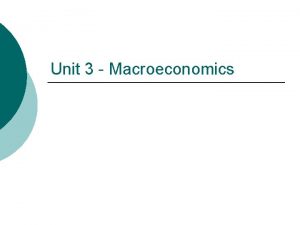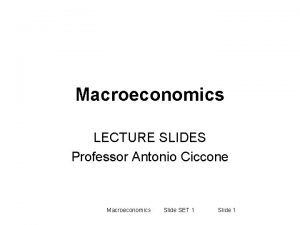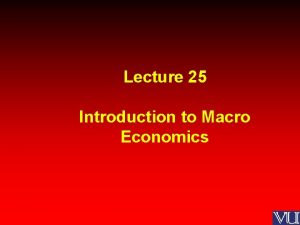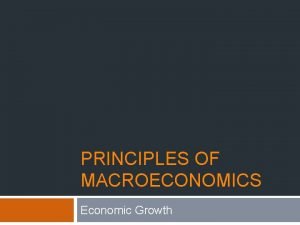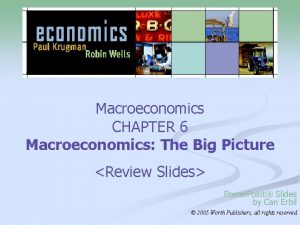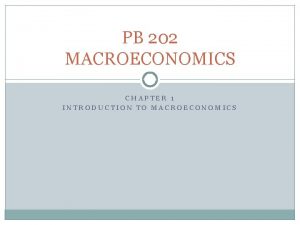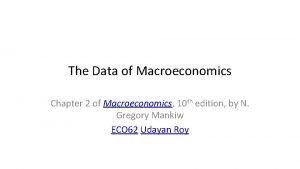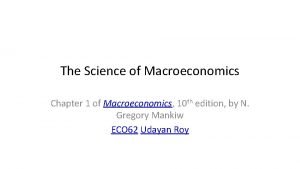Introducing Advanced Macroeconomics Chapter 3 second lecture Growth























- Slides: 23

Introducing Advanced Macroeconomics: Chapter 3 – second lecture Growth and business cycles CAPITAL ACCUMULATION AND GROWTH: THE BASIC SOLOW MODEL ©The Mc. Graw-Hill Companies, 2005

The basic Solow model (repetition) • Parameters: and. constant: we focus on capital accumulation • Given and the model determines and ©The Mc. Graw-Hill Companies, 2005

Government sector • follows from the identity/definition and the national accounting identity • Same construction with a public sector: • Insert into the identity to get ©The Mc. Graw-Hill Companies, 2005

• We can use the model as it stands. We just have to reinterpret as the sum of private and government capital stock and as the sum of private and public savings. Similarly the equation should be reinterpreted as: • The essential assumption underlying the Solow model interpreted to include a government is thus that the sum of private and public consumption as a fraction of GDP is a constant, . • This seems plausible empirically. And seems plausible for many Western countries: ©The Mc. Graw-Hill Companies, 2005

The consumption share of GDP in several Western countries ©The Mc. Graw-Hill Companies, 2005

The basic Solow model, short version • In previous lecture we saw that the Solow model leads to the transition equation: • and to the Solow equation: ”technical term” appearing because of discrete time savings per capita Replacement investment to compensate for depreciation and growth of labour force ©The Mc. Graw-Hill Companies, 2005

The Solow diagram (repetition) Why does growth in Diminishing returns! and have to stop? ©The Mc. Graw-Hill Companies, 2005

Comparative analysis in the Solow diagram 1. The economy is initially in steady state with parameters and. What happens if the savings rate increases permanently from to a new and higher level, ? ©The Mc. Graw-Hill Companies, 2005

2. The economy is initially in steady state. No parameters change, but an exogenous event, e. g. , a war or natural disaster, reduces the capital stock to half size ”over night”. How is this analysed in the Solow diagram? ©The Mc. Graw-Hill Companies, 2005

Steady state • Last time we saw that the Solow model implies convergence to a unique steady state. From the Solow equation one easily computes and then ©The Mc. Graw-Hill Companies, 2005

Some main lessons (repeated from previous lecture) • The elasticity of wrt. is : an increase in the savings rate of 10%, e. g. from 20 to 22%, gives a long run increase in income per worker of around 5% according to the basic Solow model! • The elasticity of wrt. is ! Note that the effect is stronger than one-to-one due to capital accumulation. • Another steady state prediction concerns the real interest rate… ©The Mc. Graw-Hill Companies, 2005

The ”natural” interest rate • The real rate of interest is determined by productivity and thrift in the long run (Knut Wicksell): – Higher capital is more productive demand of capital per worker increases (ceteris paribus) higher equilibrium interest rate (the price of capital). – Higher supply of capital per worker increases the equilibrium interest rate decreases. • Reasonable parameter values on an annual basis, , imply and. This value for is very close to empirical observations of the real interest rate! ©The Mc. Graw-Hill Companies, 2005

Structural policy 1. Crowding out: • • Consider a permanent fall in caused by a permanent increase in government consumption as a percentage of GDP. What happens on impact? is unaffected and still grows at the rate of , and is unaffected. But savings decrease and consumption increases. There is full crowding out. What happens in the longer run? During a transitional period grows more slowly than at the rate of and falls down to a new lower steady state level. There is more than full crowding out. And the real interest rate increases. The government cannot increase GDP by raising government expenditure in the long run. How about the short run? (Book Two) ©The Mc. Graw-Hill Companies, 2005

2. Motives for tax-financed public services from a long run perspective • Public investments (that would not be made by private agents) For government consumption: • Public (non-rival and possibly non-excludable) goods • Public consumption, e. g. , on education and health care, replacing private consumption, which means that is not affected • Distributive reasons • Externalities (education) • General productivity effects of public consumption, e. g. , judicial system, health care etc. ©The Mc. Graw-Hill Companies, 2005

3. Incentive policies: – Policies that do not affect model parameters directly through government expenditure/revenue, but indirectly through the way they affect private behaviour. We cannot analyze incentive policies explicitly because private behaviour has not been derived from optimization. – Golden rule: The that maximizes , which is , is called the golden rule savings rate. – The model suggests structural policies that • promote technology • encourage savings (assuming that is considerably below ): institutions and incentive • reduce ©The Mc. Graw-Hill Companies, 2005

Growth in the basic Solow model • The long run prediction of the Solow model is its steady state. What is the growth rate of GDP per capita in steady state? • Zero! Not in accordance with stylized facts. • What is the growth rate of in steady state? Since and is constant, and must grow at the same rate, . GDP grows, but only at the same rate as the labour force. Why is that? • Assume that the economy initially is below steady state implying that. Then , implying that capital per worker increases. But, once again, because of diminishing returns the growth in and will ultimately cease. • However, there is transitory growth. How long-lasting ©The Mc. Graw-Hill Companies, 2005 is that?

Simulation • Initially we are in steady state with the following parameter values: representing a developing country. This implies that. • With effect first time in period 1, the savings rate increases permanently to corresponding to the savings rate of a typical Western economy, implying and. • Starting with in period zero and one we now simulate over. We also calculate , etc. for and draw the evolutions of these variables in the following figures. and ©The Mc. Graw-Hill Companies, 2005

The evolution of in. , and after the increase ©The Mc. Graw-Hill Companies, 2005

The evolution of , in. (continued) and after the increase The figures show that transitory growth is relatively long-lasting. ©The Mc. Graw-Hill Companies, 2005

• In the Solow model, the transition towards steady state is at least as important as the steady state itself. And during this transition there is growth in and. Hence, the basic Solow model is a growth model! • It is easy to find the growth rate of : This is called the modified Solow equation. • The growth rate of follows from. ©The Mc. Graw-Hill Companies, 2005

The modified Solow diagram ©The Mc. Graw-Hill Companies, 2005

• Growth in GDP per worker is higher the further below steady state the economy is. This is in accordance with conditional convergence. • A permanent increase in gives a jump upwards in the growth rate of GDP per worker. ©The Mc. Graw-Hill Companies, 2005

Conclusions based on the basic Solow model • What can a (poor) country do to create a transitory growth in GDP per worker resulting in a permanently higher level of income and consumption per worker? The basic Solow model provides the following answers: – – Increase the savings rate Reduce the growth rate of the labour force Reduce the rate of depreciation, i. e. invest better Improve the level of technology • How useful are these recommendations? ©The Mc. Graw-Hill Companies, 2005
 01:640:244 lecture notes - lecture 15: plat, idah, farad
01:640:244 lecture notes - lecture 15: plat, idah, farad Advanced inorganic chemistry lecture notes
Advanced inorganic chemistry lecture notes Politics definition
Politics definition Operational definition of affection
Operational definition of affection Advanced word power second edition answers
Advanced word power second edition answers Ten steps to advanced reading 2nd edition answers
Ten steps to advanced reading 2nd edition answers Chapter 31 open economy macroeconomics
Chapter 31 open economy macroeconomics Macroeconomics chapter 7
Macroeconomics chapter 7 Macroeconomics chapter 8
Macroeconomics chapter 8 Vertical supply curve
Vertical supply curve 186 282 miles per second into meters per second
186 282 miles per second into meters per second Absolute growth rate and relative growth rate
Absolute growth rate and relative growth rate Monocot vs eudicot
Monocot vs eudicot Step growth polymerization vs chain growth
Step growth polymerization vs chain growth Primary growth and secondary growth in plants
Primary growth and secondary growth in plants Chapter 35 plant structure growth and development
Chapter 35 plant structure growth and development Geometric growth vs exponential growth
Geometric growth vs exponential growth Neoclassical growth theory vs. endogenous growth theory
Neoclassical growth theory vs. endogenous growth theory Organic growth vs inorganic growth
Organic growth vs inorganic growth Signal phrase example
Signal phrase example Answer key
Answer key Introducing james joyce
Introducing james joyce Introducing a quote starters
Introducing a quote starters Counterclaim definition in argumentative writing
Counterclaim definition in argumentative writing


